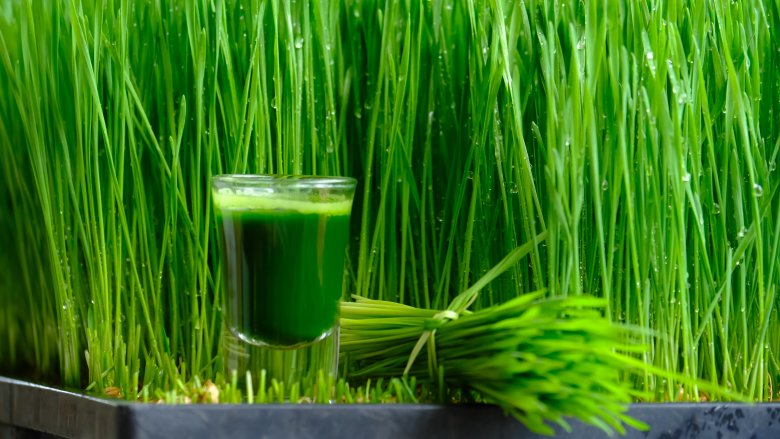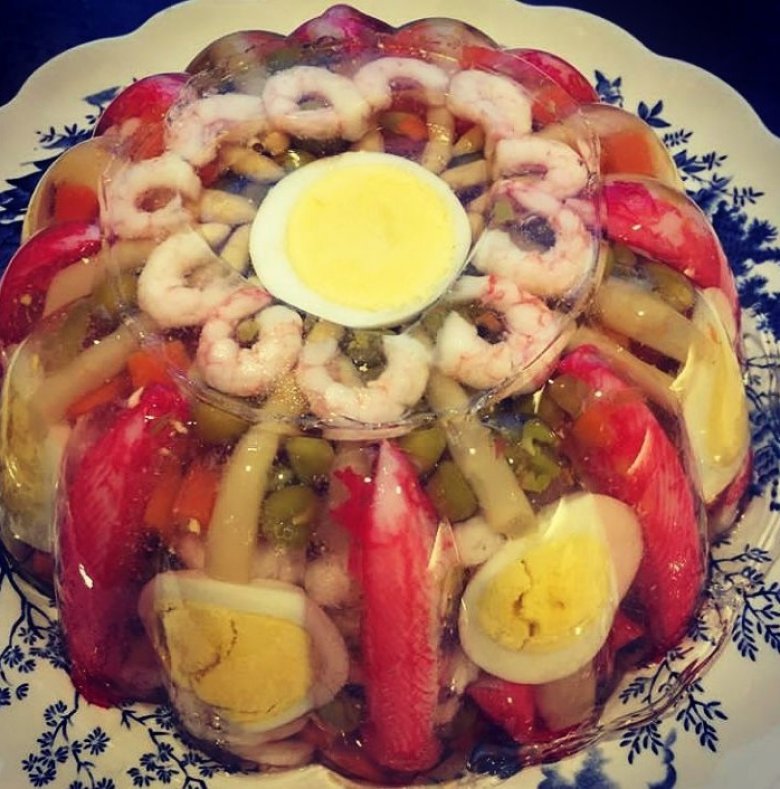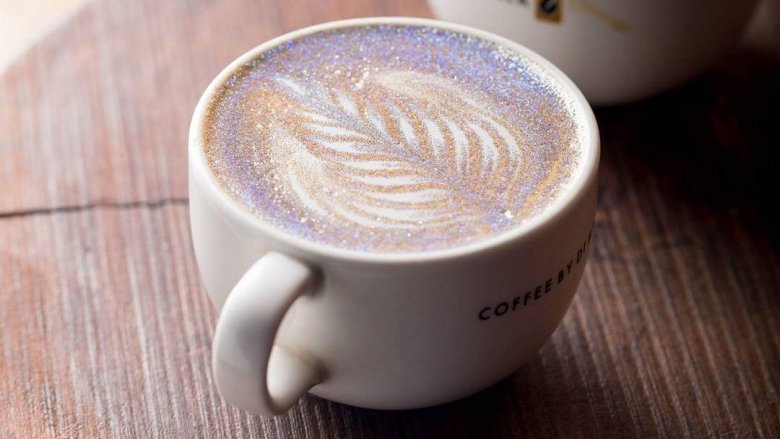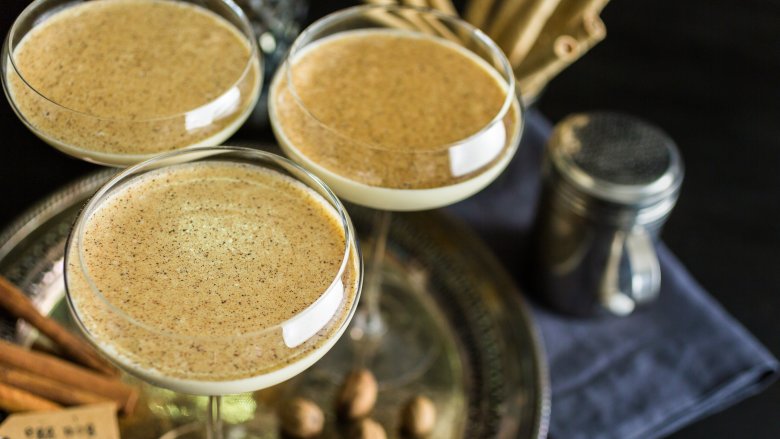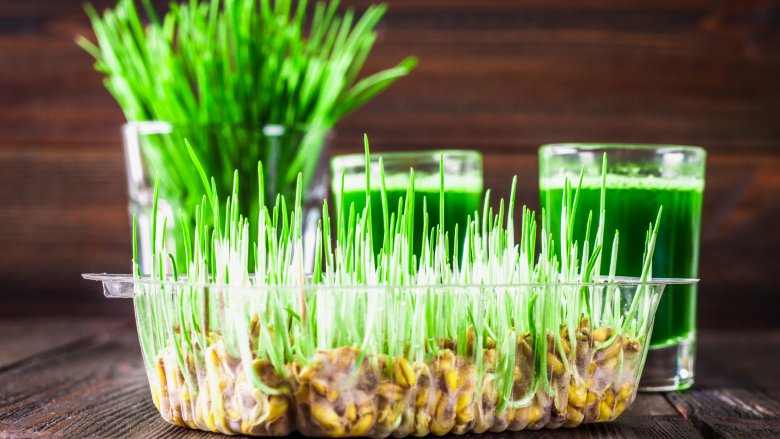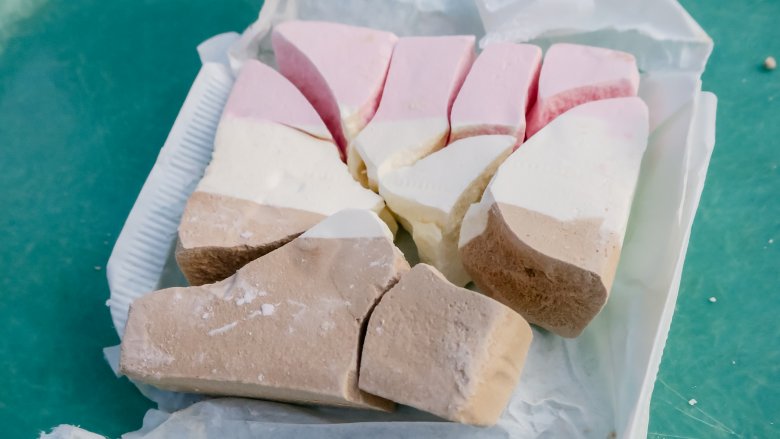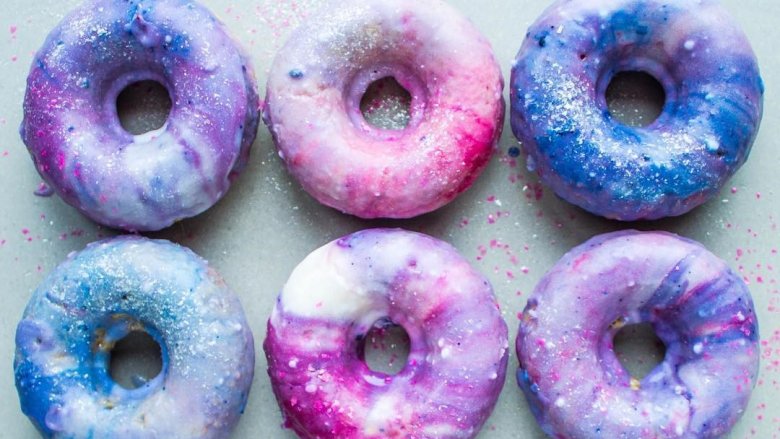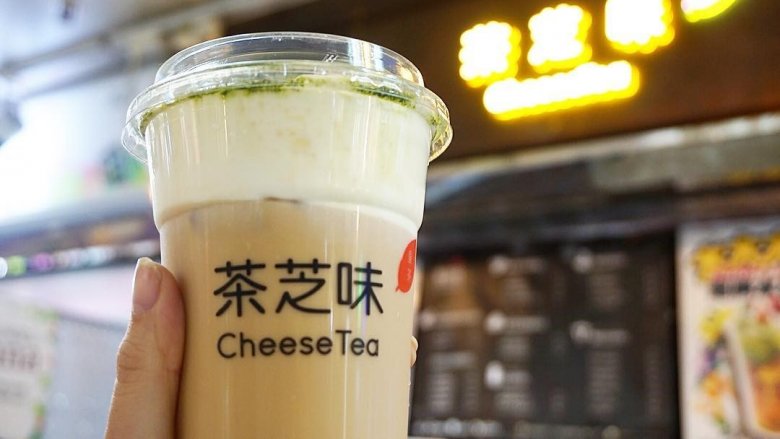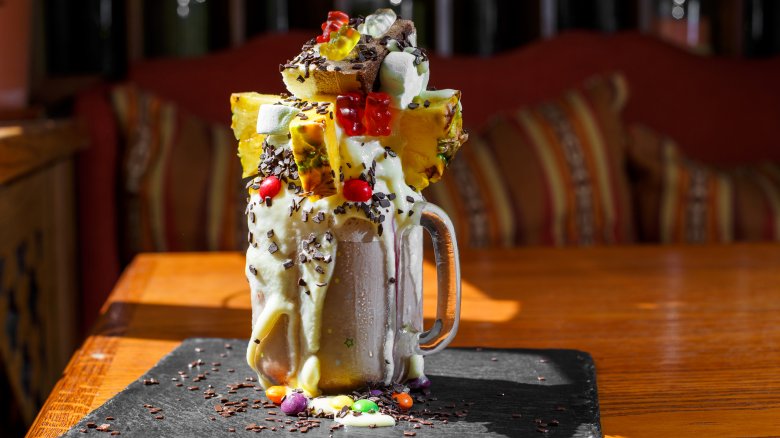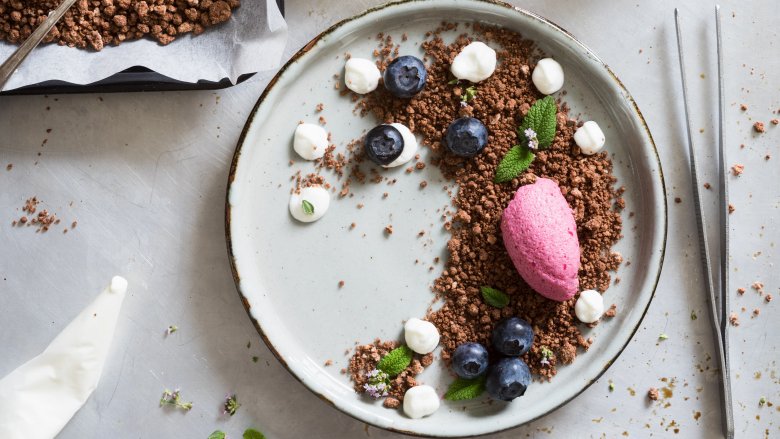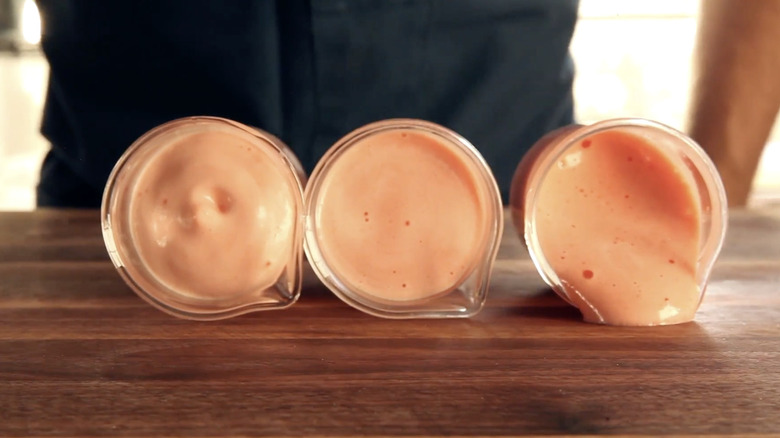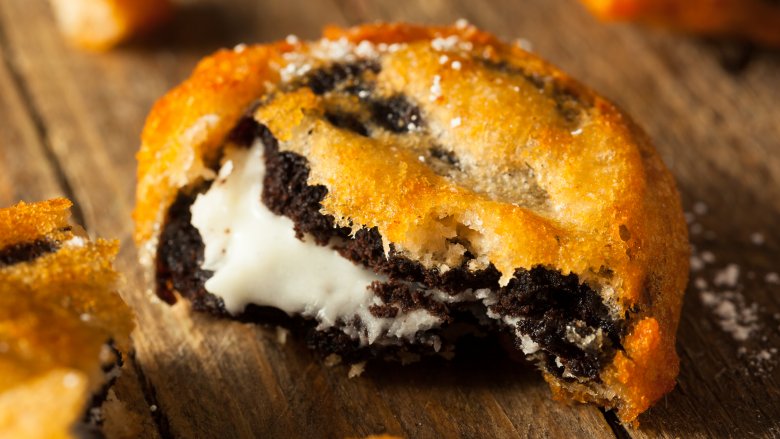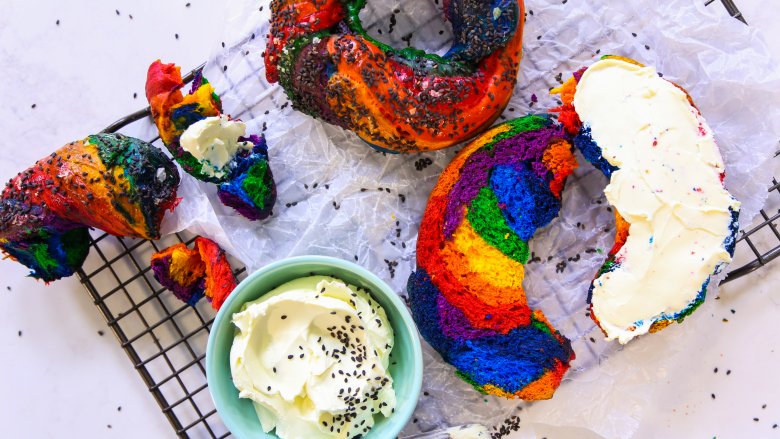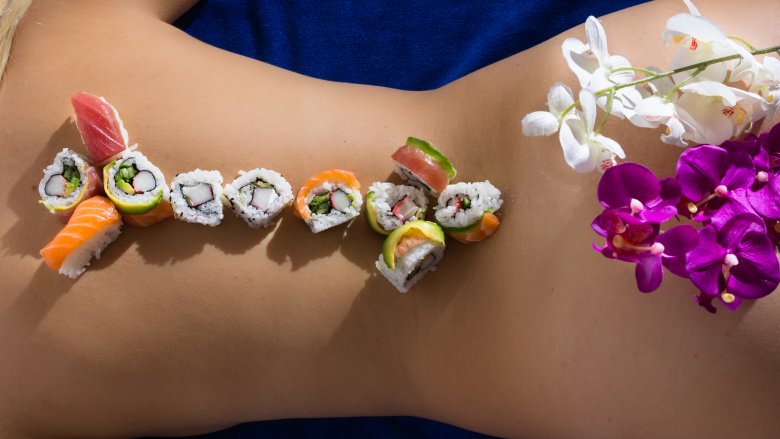The Weirdest Food Trends In History
Food trends are a very strange thing. Some of them are fun, delicious or healthy, which makes it easy to see why so many people are quick to hop on board. But some other food trends... well, they tend to leave us scratching our heads in confusion (and sometimes curiosity). You know exactly the sort of thing we're talking about, those strange food trends that take Instagram by storm but usually just leave you wondering exactly how you're supposed to go about eating these things — or why anyone would actually want to. It's not just the Instagram age that has seen all these weird fads popping up — though social media does help these odd ball foods spread faster than they ever did. For decades, the collective consciousness has been captivated by the next new thing and when it comes to food, some of it is just downright bizarre. These are some of the strangest food trends in history.
Congealed salads
There are a few words that should probably never be used to describe food, and "congealed" is one of them. In the 1930s, though, congealed salads — otherwise known as Jell-O salads — were all the rage. They weren't just easy to make, but you could put almost anything in a mold with some Jell-O. Whether or not you actually should do it is another story, but Food 52 says it was the Great Depression and people were looking for just a little bit of hope and sunshine wherever they could find it. Enter the congealed salad, and Jell-O was pushing recipes that sounded exciting, like "Oriental Compote" (peaches, peach juice, lemon or orange Jell-O, and cooked rice), and "Spanish Jell-O Salad" (lemon Jell-O, pimientos, celery, pickles, white cabbage and vinegar). That might make you believe that "congealed" is the nicest thing you'll be able to say about this idea... but it gets worse.
The National Museum of American History picked out just a few of the wide range of gelatin dishes they found in their Depression-era cookbooks, and gave them a go. Among their recipes were a chicken salad olive mold, tomato aspic, a molded mayonnaise salad, and a "surprise loaf," which could honestly describe any of these dishes.
Glitter coffee
Glitter isn't new, and edible glitter isn't even new, we're sorry to say. But it wasn't until 2017 that news outlets like Metro started reporting that a Mumbai coffee chain called Coffee By Di Bella had started using edible glitter to jazz up their cappuccinos. They also say another UK coffee chain picked up on the glitter trend and decided to use gold glitter for their sparkly beverages. So why is this being done to our coffee? Because it's all about the presentation. Information on whether or not the glitter gets stuck in your insides as relentlessly as it gets stuck everywhere else isn't included in the menu description.
Colonial syllabubs
Some olde-timey drinks still taste delicious to our modern-day taste buds. Mead is a perfect example, and if you love honey and wine, there's no way you can't get on board with a honey wine. But according to Colonial Williamsburg, a completely cringe-worthy dessert drink was all the rage during the 18th century. It was called syllabubs, and it was essentially made by mixing a cream, an acid, and wine. A 1753 book called The Complete Housewife gave a recipe that included cream, Rhenish wine, sugar, and lemons. Yum? It would last for days (but would separate and need to be re-mixed), and other recipes even suggest you could change the color with a bit of saffron or spinach juice. For a 21st century version just mix up heavy whipping cream, sherry, a lemon, sugar, and a dash of red wine... then add some spinach juice and see how it goes down.
Eating grass
Those wheatgrass shots that are popular today have a long (and kind of dark) history. In 1956, Ann Wigmore founded the Hippocrates Health Institute, and Refinery 29 says it earned itself a bit of notoriety in 2015 when an 11-year-old girl died following their grass- and enema-based treatment for acute lymphoblastic leukemia. The clinic's foundation was built on Wigmore's steadfast belief that not only were raw foods the best, but that they could cure disease. Especially effective? Eating wheatgrass.
The Lithuanian-born Wigmore helped her grandmother treat the injured during World War I, and it was then she started developing the idea that eating grass was the best thing you could do for your body. That idea was cemented when — she says — she healed two broken, gangrenous legs by eating grass, and once she started preaching that grass and weeds were the manna described in the Bible, she kicked off the trend of adding grass to not just diets but medical treatments. Calling herself Reverend Ann Wigmore, she started down the road of insane claims and less insane lawsuits, swearing grass could do everything from relieving arthritis to curing cancer and AIDS. It can't, but when she died in 1994, she left behind a mansion and a fortune. That says something.
Freeze-dried astronaut food
For decades, it didn't get any cooler than being an astronaut. We were obsessed with the idea that we could blast into space and float among the stars, so it's not entirely surprising that once we figured out we didn't even have to leave Earth to eat like an astronaut, we were totally down with that.
Gizmodo says it was in the 1960s that mass media was running with the idea that freeze-dried astronaut food was going to be the way of the future. It was space-saving, it was economical, and it was efficient. And even better? It was cool! If you didn't have freeze-dried ice cream at least once during your childhood, you were seriously missing out — and you need to get some. This particular trend may not have taken off like the media predicted, but you can still pick up some freeze-dried foods just for nostalgia's sake.
Galaxy food
Thanks to social media — and especially sites like Instagram and Pinterest — we're developing all kinds of food trends whose popularity hinges on appearance rather than just on taste... and there's not really anything wrong with that. Just look at the trend of galaxy-themed desserts. They look amazing, and they're everything from cakes and cookies to candy apples and lollipops, all decorated to look like something that was plucked right out of the night sky. Brit + Co. says this particular trend started in 2016 on the heels of another colorful trend — the rainbow — and it's just as glittery, just as beautiful, and just as impressive.
Cheese tea
Quick, think of two types of deliciousness that absolutely should, under no circumstances, be mixed together. If you said "cheese" and "tea", you'd probably agree with a ton of people — but another ton swear it's the best thing since sliced bread.
According to The Independent, this particular trend started in Taiwan and to be more precise about it, it's iced tea topped with whipped cheese. Does the clarification make it any better? We're not sure, but they also report there's a few different kinds, including green tea and salted cheese, and chocolate with — wait for it — salted cheese. The trend started by using powdered cheese and moved on to incorporate whipped cream cheese, and it started to spread outside of Taiwan by hitting the US and the UK first. Considering how seriously the Brits take their tea, this is pretty much blasphemy.
Freakshakes
If we had to guess how freakshakes got started, we'd say someone accidentally dropped a mason jar into a pot of hot fudge, didn't want to take the time to wash it off, and just figured they'd go for the messy look. The Guardian says they started in Canberra, Australia, and invaded the rest of the world from there, and honestly? At least this is one atrociously indulgent, over-the-top dessert you can't blame the US for. They're pretty simple to make: fill a container with a milkshake, top with cream, then cake, then douse the entire thing — glass included — with sauce. Stick on whatever decorative bits happen to be laying around (candy bars, waffles, hamburgers, who cares?!), then photograph and put on Instagram.
Then you can eat it, but you should probably be near a communal bath (or at least a dozen packages of wet wipes). Food analysts suggest this is one trend that exists only to be documented on social media, and when Guardian columnist Hilary Osborne recruited her 6-year-old son to participate in a freakshake-building exercise, even he declared it was too sweet to actually eat. Any more questions?
Edible dirt
Edible dirt is something you can spot at both a child's Halloween party, or a posh, Michelin-star restaurant. According to Time, it was Noma's chef Rene Redzepi who came up with the idea of edible dirt, and other restaurants ran with it. The idea is to use something — Redzepi uses dried malt and beer — to simulate dirt, spread on the plate or filling pots that are served to guests to remind them of just where their food is coming from. It's used as a garnish for everything from mushrooms to edible flowers, it's made from things like dried olives, chickpeas, and charred onions, and it's always weird. Redzepi simply plants a whole, raw radish in his dirt-filled pot, and if you're not sure how you'd feel about paying good money for that, you're definitely not alone.
Foams
There's a familiar kind of food foam that's been popular for centuries: the souffle. More recently, chefs have been experimenting with using things like agar, egg whites, milk, and cream to create decorative foams to add to any number of fancy-pants dishes. The Science of Cooking says it's a pretty interesting chemical reaction that allows for the creation of the foams, and it all has to do with rearranging proteins in some of these common ingredients. They can even be made more stable and long-lasting by adding sugar or even using a copper bowl, and that's some neat science.
What's the point? They toss around terms like "mouthfeel", but if you're less poncy, the alternate answer is that foams are sometimes used as a lighter version of a sauce.
Deep-fried everything
There are a lot of incredibly important discoveries that have been made over the course of mankind's existence, and the discovery that you can deep-fry pretty much anything set a massive precedent for American food trends in the 21st century. Are we proud of this? We're not sure, but you have to admit the fact you can deep-fry soda is pretty impressive.
The Chicago Tribune took a look at just some of the foods that the human race has managed to successfully deep fry, and what else is on the list? Pizza, Reese's Peanut Butter Cups, Oreos, cheesecake, apples, Moon Pies, cupcakes, jelly beans, starfish, tarantulas, seahorses, and more bugs than you'd be comfortable thinking about. Also, Jezebel says deep-fried beer ravioli are a thing, too, and that's definitely important.
Rainbow foods
Take a quick glance at almost any food-related Instagram and you'll find some rainbow food. The trend seems to have hit its height in spring and summer of 2017, and it's a trend that just needed to be stopped. It's indicative of our social media-obsessed culture, after all, and while there are some things that seem like they were made to be turned into rainbow-inspired creations (we're thinking about things like cakes and cupcakes), others? Maybe, not so much. There's rainbow burgers (meat and bun), rainbow sushi, rainbow grilled cheese, rainbow bagels, rainbow pizza, and there's even rainbow hot dogs. That all brings us to a very, very important question: what will future generations think when they see your Instagram?
Naked sushi models
It's safe to say that no matter what your likes and dislikes are, we can all agree we want our food to be safe, and prepared and served in a hygienic environment. That's what makes the idea of eating sushi off a naked woman so gosh darn weird, and in 2008 Vanity Fair ran a piece by a woman who actually had stripped down, sprawled out across a table, and had people pluck sushi off her naked body. Apparently, it's just as weird and uncomfortable for the diners as it is for the... dinnerware? It's a practice called nyotaimori, which Kotaku says means "female body arrangement", and they also say it's not as mainstream as you'd think it would be in Japan. The idea went West in the 1990s, became popular thanks to movies and the media, and is still a trendy thing in restaurants that want to give people a memorable experience more than a good meal — or any sort of tradition. It's reportedly even a bit too much for the yakuza, and that pretty much says it all.
